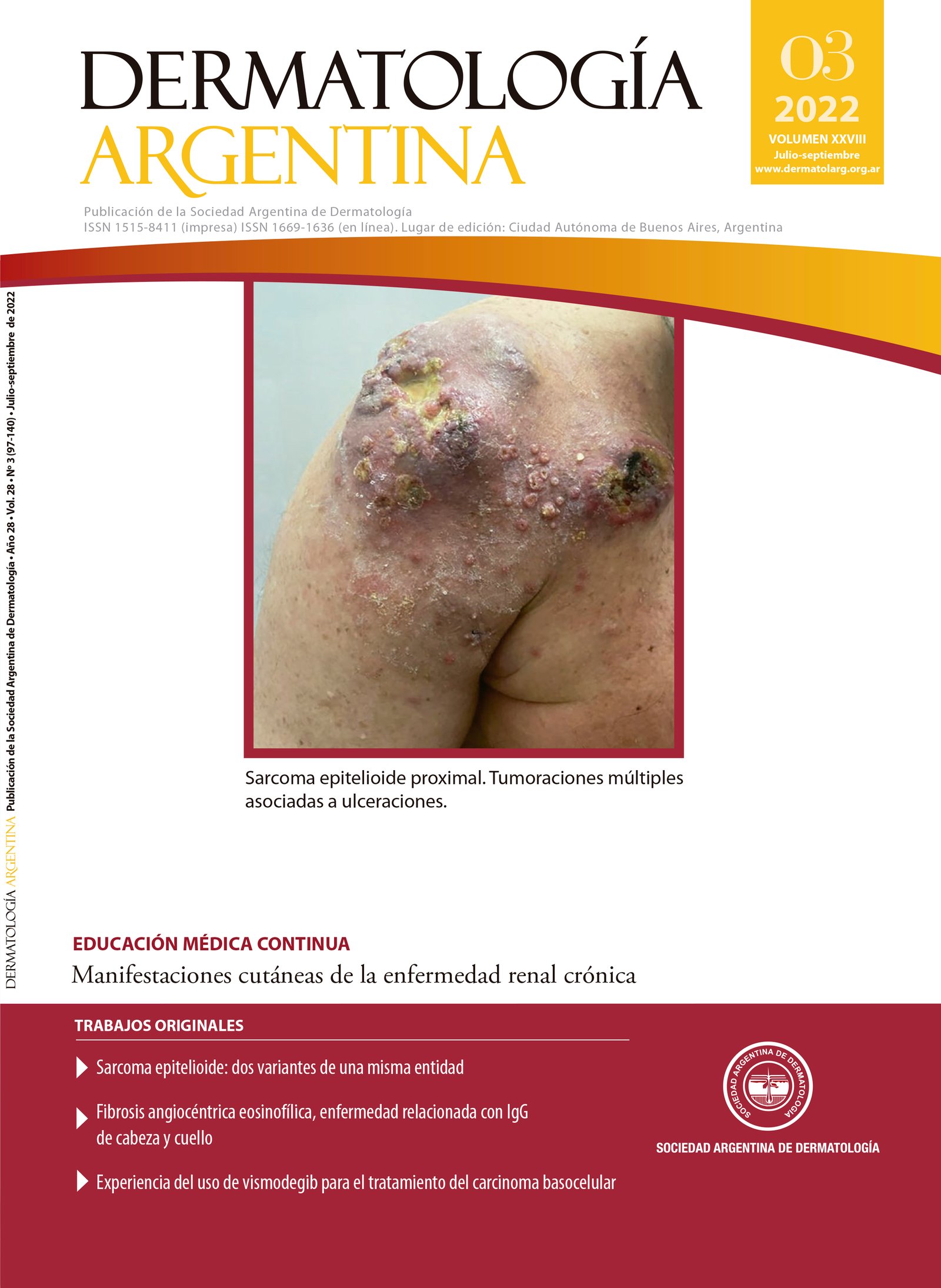Cutaneous T-cell lymphoma and multiple myeloma in the same patient
Keywords:
cutaneous T-cell lymphoma, myeloma, B-cell malignancy, Sezary syndrome, mycosis fungoidesAbstract
The coexistence in the same patient of T-cell cutaneous lymphoma and a B-cell malignancy such as a multiple myeloma is unusual. We present a 76-year-old man with erythroderma, lymphadenopathy and circulating Sézary cells, diagnosed as Sézary Syndrome. At the same time, a concomitant high-risk IgG kappa multiple myeloma was diagnosed. The origin of this association is not defined, which could correspond to the malignant transformation of a cell with T or B differentiation capacity, or to the immunoregulatory alterations that the initial neoplasia could generate on the development of the second. It is important to be aware of this rare association for the correct diagnosis and appropriate treatment of both diseases.
References
I. Kempf W, Mitteldorf C. Cutaneous T‐cell lymphomas. An update 2021. Hematol Oncol. 2021;39:46-51.
II. Olsen EA, Whittaker S, Kim YH, Duvic M, et ál. Clinical end points and response criteria in mycosis fungoides and Sézary syndrome: a consensus statement of the International Society for Cutaneous Lymphomas, the United States Cutaneous Lymphoma Consortium, and the Cutaneous Lymphoma Task Force of the European Organisation for Research and Treatment of Cancer. J Clin Oncol. 2011;29:2598-2607.
III. Abeldaño A, Enz P, Maskin M, Cervini B, et ál. Primary cutaneous lymphoma in Argentina: a report of a nationwide study of 416 patients. Int J Dermatol. 2019;58:449-455.
IV. Alonso B, Arias M, Abeldaño A. Síndrome de Sézary. Etiopatogenia, epidemiología, clínica, diagnóstico y pronóstico. Dermatol Argent. 2020;26:02-10.
V. Corzo A, Fantl D, Garate G, Giannini ME, et ál. Guías de Diagnóstico y Tratamiento de la Sociedad Argentina de Hematología. 2021:135-143.
VI. Grange F, Avril M-F, Esteve E, Joly P, et ál. Co-existent cutaneous T-cell lymphoma and B-cell malignancy. French Study Group on Cutaneous Lymphomas. J Am Acad Dermatol. 1994;31:724-731.
VII. Gernone A, Frassanito M, Pellegrino A, Vacca A, et ál. Multiple myeloma and mycosis fungoides in the same patient: clinical, immunologic, and molecular studies. Ann Hematol. 2002;81:326-331.
VIII. Goto S, Sato M, Kaneko R, Itoh M, et ál. Analysis of Th1 and Th2 cytokine production by peripheral blood mononuclear cells as a parameter of immunological dysfunction in advanced cancer patients. Cancer Immunol Immunother. 1999;48:435-442.
IX. Cartron G, Roingeard P, Benboubker L, Vaillant L, et ál. Sezary syndrome in a patient with multiple myeloma: demonstration of a clonally distinct second malignancy. Eur J Haematol. 1999;63:354-357.
X. Barzilai A, Trau H, David M, Feinmesser M, et ál. Mycosis fungoides associated with B‐cell malignancies. Br J Dermatol. 2006;155:379-386.
Downloads
Published
Issue
Section
License
Copyright (c) 2022 on behalf of the authors. Reproduction rights: Argentine Society of Dermatology.

This work is licensed under a Creative Commons Attribution-NonCommercial-NoDerivatives 4.0 International License.
El/los autor/es tranfieren todos los derechos de autor del manuscrito arriba mencionado a Dermatología Argentina en el caso de que el trabajo sea publicado. El/los autor/es declaran que el artículo es original, que no infringe ningún derecho de propiedad intelectual u otros derechos de terceros, que no se encuentra bajo consideración de otra revista y que no ha sido previamente publicado.
Le solicitamos haga click aquí para imprimir, firmar y enviar por correo postal la transferencia de los derechos de autor












